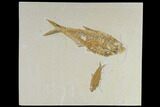This Specimen has been sold.
7.8" Diplomystus Fossil Fish With Knightia - Wyoming
This two fossil fish from the Eocene aged Green River Formation of Wyoming, a 7.8" Diplomystus and a 2.9" knightia. Both the Knightia and Diplomystus show bones and fin rays.
It comes with an acrylic display stand.
It comes with an acrylic display stand.
About Diplomystus
Diplomystus is an extinct genus of freshwater, ray-finned predators that are distantly related to modern herrings and sardines. Diplomystus has a distinctive jaw that protrudes aggressively outward from the mouth at an angle that allowed it to feed in surface waters and devour such prey as the smaller, schooling Knightia.
50 million years ago in the Eocene (55.8 mya to 33.8 mya), D. dentatus thrived in lakes fed by the Uinta and Rocky Mountain highlands. D. dentatus is uniquely entombed in the fine-grained lime mud of Fossil Lake.
The anoxic conditions at the bottom of Fossil Lake slowed bacterial decomposition, prevented scavengers from disturbing corpses, and, most interestingly, suffocated creatures that ventured into the oxygen-starved aquatic layer. The result is a miraculous exhibition of Eocene biota in a subtropical aquatic community within sycamore forests, teeming with creatures such as freshwater stingrays, dog-sized horses, menacing alligators, early flying bats, and one of the first primates.
By the end of the Eocene, Earth developed icehouse climate characteristics and had a change in atmospheric chemistry. The effects of bolide impacts may also have contributed to the eventual loss of flora and fauna at once verdant latitudes.
Today the wonderfully preserved fossils of Diplomystus and other Fossil Lake fauna are collected in several private quarries around Kemmerer, Wyoming. The best preserved fish fossils come from the coveted 18 Inch Layer. This layer is collected at night under high-powered lights, enhancing the faint signs of fish under the surface indicating underlying fossils. These “ghosted” fish then must go through many hours of manual preparation to remove the overlying rock and reveal the Green River fauna in all of its glory.
Diplomystus is an extinct genus of freshwater, ray-finned predators that are distantly related to modern herrings and sardines. Diplomystus has a distinctive jaw that protrudes aggressively outward from the mouth at an angle that allowed it to feed in surface waters and devour such prey as the smaller, schooling Knightia.
50 million years ago in the Eocene (55.8 mya to 33.8 mya), D. dentatus thrived in lakes fed by the Uinta and Rocky Mountain highlands. D. dentatus is uniquely entombed in the fine-grained lime mud of Fossil Lake.
The anoxic conditions at the bottom of Fossil Lake slowed bacterial decomposition, prevented scavengers from disturbing corpses, and, most interestingly, suffocated creatures that ventured into the oxygen-starved aquatic layer. The result is a miraculous exhibition of Eocene biota in a subtropical aquatic community within sycamore forests, teeming with creatures such as freshwater stingrays, dog-sized horses, menacing alligators, early flying bats, and one of the first primates.
By the end of the Eocene, Earth developed icehouse climate characteristics and had a change in atmospheric chemistry. The effects of bolide impacts may also have contributed to the eventual loss of flora and fauna at once verdant latitudes.
Today the wonderfully preserved fossils of Diplomystus and other Fossil Lake fauna are collected in several private quarries around Kemmerer, Wyoming. The best preserved fish fossils come from the coveted 18 Inch Layer. This layer is collected at night under high-powered lights, enhancing the faint signs of fish under the surface indicating underlying fossils. These “ghosted” fish then must go through many hours of manual preparation to remove the overlying rock and reveal the Green River fauna in all of its glory.
About Knightia
Knightia is an extinct genus of small, schooling, ray-finned fish related to modern herrings and sardines. Abundant in the warm freshwater lakes of the Eocene Green River Formation, they fed on insects, plankton, and tiny fish, while serving as prey for nearly every larger predator in the ecosystem. The most common species, Knightia eocena, reached about 15 cm in length and is celebrated today as the state fossil of Wyoming.
These streamlined fish are recognized by their heavy scales, small conical teeth, and rows of dorsal and ventral scutes along the body. Their fossils are among the most iconic from the Green River Formation—an exceptional 48-million-year-old lake deposit in Wyoming, Colorado, and Utah known for preserving a remarkably detailed snapshot of ancient life in a warm, lake-rich Eocene landscape.
Knightia is an extinct genus of small, schooling, ray-finned fish related to modern herrings and sardines. Abundant in the warm freshwater lakes of the Eocene Green River Formation, they fed on insects, plankton, and tiny fish, while serving as prey for nearly every larger predator in the ecosystem. The most common species, Knightia eocena, reached about 15 cm in length and is celebrated today as the state fossil of Wyoming.
These streamlined fish are recognized by their heavy scales, small conical teeth, and rows of dorsal and ventral scutes along the body. Their fossils are among the most iconic from the Green River Formation—an exceptional 48-million-year-old lake deposit in Wyoming, Colorado, and Utah known for preserving a remarkably detailed snapshot of ancient life in a warm, lake-rich Eocene landscape.
SPECIES
Knightia eocaena, Diplomystus dentatus
LOCATION
Kemmerer, Wyoming
FORMATION
Green River Formation
SIZE
7.8" diplomystus, 11.2 x 9.3" rock
CATEGORY
SUB CATEGORY
ITEM
#119472
We guarantee the authenticity of all of our specimens.
 Reviews
Reviews














